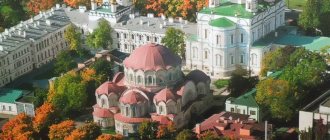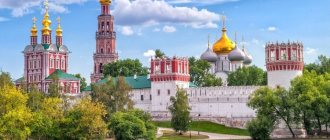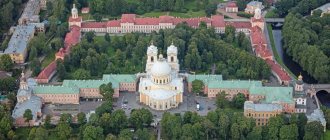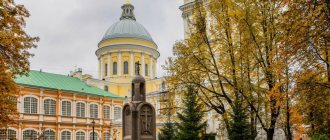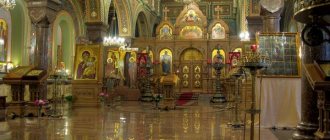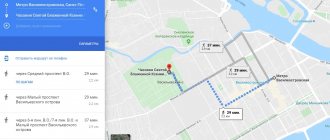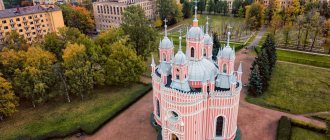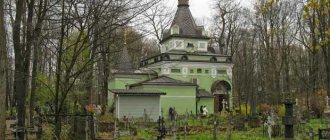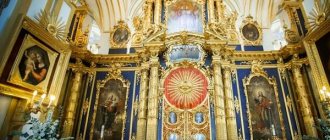Saint Petersburg. Moskovsky Avenue near the Novodevichy Convent, early 1930s.
Novodevichy Convent in St. Petersburg... The hum of cars and voices does not cease on Moskovsky Avenue, day or night. It seems that the solitude so necessary for monasticism is unattainable in a noisy city. And yet, the thirty sisters living in the monastery offer prayers and perform obediences daily and hourly for the good of their neighbors and for the glory of the Lord.
Where is the Resurrection Novodevichy Convent located in St. Petersburg
The Novodevichy Convent is the center of spiritual life in St. Petersburg. It is located near the Moskovskaya Zastava, between the Frunzenskaya and Moskovskie Vorota metro stations.
How to get there
It’s closer to get there from the “Moscow Gate”. Having risen from the metro, you need to cross the avenue and walk a little back, towards Frunzenskaya. The journey to the monastery takes just over 15 minutes. The golden domes of the temples behind the high fence are noticeable from afar.
Novodevichy Convent on the map of St. Petersburg. Photo
Novodevichy Convent in St. Petersburg
Novodevichy Cemetery
At the Novodevichy Convent in the Northern capital there is a cemetery of the same name. It was officially opened in 1848, although burials in the churchyard took place much earlier. The cemetery is the last monastery to this day, despite the fact that it was closed in 1834.
The cemetery is famous for the burial of famous people, heroes of the Russian-French war. Here you can find the graves of aristocrats, famous writers, composers, and artists.
After the 1917 revolution, the necropolis was abandoned and was plundered. Expensive jewelry, tombstones, and tiles were taken out of the crypts. Before these sad events, there were two churches on the territory of the churchyard: Kazanskaya and Ilyinskaya. After the civil war they were completely destroyed.
Much later, the monuments were restored and repairs and cleaning of the area began. Now the cemetery is a beautiful and well-kept graveyard.
Service Schedule
You can attend the service any day of the week.
On weekdays:
- By 9.30 the bells call parishioners to the liturgy;
However, if it’s Lent, you should arrive 2.5 hours earlier – by 7:00.
- By 5 p.m., believers gather for Vespers.
On Saturdays:
- The Divine Liturgy is served a little earlier than on weekdays - at 9.00;
- the day ends with the All-Night Vigil at 17.00.
Sunday is a special day, therefore:
- The Liturgy will be preceded by the reading of an akathist to Hilarion of the Trinity at 8.40;
- The Liturgy, as on ordinary days, begins at 9.30;
- The Vespers day ends at 17.00.
After Vespers you can go to confession, the day after the Liturgy you can receive Holy
Communion of Christ
Useful tips for visitors
Here's what you need to know:
- Ticket price – entry to the cathedral is free.
- Worship services are held every day.
- Opening hours are on weekdays from 8:30 until the end of the evening service, which is at 20:00. From Saturday to Sunday it opens an hour earlier.
- It is possible to order a wedding ceremony, baptism, memorial service and prayer service.
- There is a priest on duty in the cathedral throughout the day, who can be contacted with any questions of concern.
- Women should visit the temple in a skirt that falls below the knees and with their heads covered with a headscarf. Cosmetics are not allowed.
- You can take photos, but not during the service.
Group and individual excursions lasting 30-60 minutes around the cathedral are held daily. Temple workers can conduct them for a donation; there is no specific schedule. The program includes an introduction to the history of the temple, inspection of its shrines, relics and architecture. At this time, visitors should not speak loudly, disturbing others, or sit on benches. Exceptions in the Kazan Cathedral are made only for elderly people and people with disabilities.
We recommend visiting the Hagia Sophia Cathedral.
Schedule of services: morning liturgy - 7:00, late - 10:00, evening - 18:00.
Contacts
Address: 196084, St. Petersburg, Moskovsky Prospekt, 100
Website: https://vnodevichiy.rf/
If you have questions, you can ask the nurses and employees by phone:
- (81225) 2-11-66 – for general questions;
- (81236) 9-30-98 – church shop;
- (81225) 2-37-59 – Pilgrim’s House;
- (81238) 7-44-37 – St. Vladimir’s secondary school;
- (950) 000-27-46 – Sunday school;
- (905) 256-23-12 – Compound in the village. Lisino-Korpus.
For questions regarding accommodation of organized pilgrimage groups, you can write to
Abbess Sofia
Since 2007, Abbess Sofia (Silina Yulia Borisovna) . Mother was born on November 18, 1972 into a non-religious family. The only believing Christian was her Cossack great-grandmother, who carried her faith through all persecution and prohibitions.
Abbess Sofia (Silina Yulia Borisovna)
In her youth, the girl Julia began to think about the meaning of life and visit the temple. The parish priest became her mentor and friend. Already a student at the Faculty of Law at St. Petersburg State University, Yulia communicated with monks and received a blessing to become a monk.
In 1992, the future abbess entered the Resurrection Novodevichy Convent as a novice. Four years later, she took monastic vows and the name of the holy martyr Sophia of Rome. Today she leads the life of a huge monastery - both its material and spiritual sides.
“I always dreamed of having at least ten children,” says the abbess, “and God gave me much more. Now I have both small and big children.”
Shrines of the monastery
The Resurrection Novodevichy Convent is the only one in St. Petersburg where such a large number of church relics are kept:
- Mother of God icons “Kazan”, “Athos”, “Akhtyrskaya”, “Consolation and Consolation”;
- a piece of the belt of the Virgin Mary with pieces of the holy remains of Joachim and Anna;
- miraculous relics of Princess Olga, Matrona of Moscow, John of Damascus, Mary of Gatchina;
- sculpture of Jesus Christ;
- a piece of the Life-Giving Cross.
Image of the Mother of God “Fragrant Flower”
Story
The first sister community appeared in the monastery back in the 18th century, but its existence was short-lived. However, God still wanted the monastery to be revived. And it was reborn over and over again, no matter how many times it was destroyed.
What happened "before"
The initiator of the creation of the monastery on the site of the wooden Smolny Palace was Empress Elizaveta Petrovna . This was her gift to the Lord for answering fervent prayers and helping the then young girl ascend to the throne.
St. Petersburg: Resurrection Novodevichy Convent on Moskovsky Prospekt
Elizabeth donated the territory of her own palace for the new monastery, entrusting the work on the project to the famous architect Rastrelli . This happened in 1746. Soon the first nuns arrived at the monastery. But there was no strong community. After the death of the last nuns, the monastery was closed, but in its place the first women's boarding school appeared - the famous Smolny Institute.
From foundation to liquidation
The monastery was revived in the middle of the 19th century through the efforts of Nicholas the First .
Especially for this purpose, a cell building was built at the Moscow outpost, where the nuns safely moved in 1854 from their temporary refuge on Vasilievsky Island.
Interestingly, the cemetery appeared much earlier, in 1845, and initially did not belong to the monastery.
The Kazan Church was the first to be erected among others. The wooden temple lasted eighty years.
On November 3, 1849, the foundation of the Resurrection Cathedral was laid, and 12 years later the first service was held here.
Almost immediately after the revolution, when the decree “On the separation of church and state” came into force, the Novodevichy Convent was ruined, but for several more years it existed in private form.
Soviet time
Until 1937, the monastery was the residence of the Metropolitans of Leningrad. Under Seraphim (Chichagov) in 1932, the sisters of the monastery were arrested and expelled, and under Alexy (Simansky) the monastery ceased to exist, the metropolitan himself was expelled and until 1940 he lived in the bell tower of the Prince Vladimir Cathedral. The final liquidation with confiscation of all lands and premises followed in 1937.
Interesting fact:
On the night of April 17-18, 1932, 126 sisters were arrested at the Novodevichy Convent.
Only the elderly and sick who could not move were left behind. The communists destroyed the bell tower, which interfered with road construction, and removed the domes of the Resurrection Cathedral. The main building houses the Electrical Mechanical Engineering Research Institute.
In the building of the Cathedral of the Resurrection of Christ in the 1960s, the Repository of the State Archive of the October Revolution and Socialist Construction was located
Post-Soviet
The second birth of the monastery occurred shortly before the collapse of the USSR, when in 1989 the oldest Kazan church was returned to the Russian Orthodox Church . But it took another six years to restore the legal status of the monastery.
And only at the end of 2001 the government decided to return to the monastery all the property and lands that belonged to it before the revolution. A year later, restoration and reconstruction began.
Church in the name of the Kazan Icon of the Mother of God before restoration. 1990s
Renaissance
Restoration of the monastery
The revival of the monastery began in 1996. And it seems absurd that at the end of the 20th century in the center of St. Petersburg, the sister community initially had to huddle in a room without heating, water supply or sewerage. But despite all the everyday difficulties, the monastery came to life. Temples and buildings were gradually returned to him. True, they all required major repairs.
The work to revive the monastery was more than once accompanied by miracles. Thus, on November 6, 1996, the icon of the Kazan Mother of God was renewed without any restoration. A case that cannot be explained by physical laws. The discovery of the grave of the first abbess Feofaniya is also considered a miracle. During Soviet times, it was desecrated and was under asphalt.
By 2002, all buildings were returned to the monastery. This “island of eternity” has come to life again among the bustle of St. Petersburg. Today the Kazan, Athos and Vvedensky churches have been renovated. A chapel was built in the name of Sergius of Radonezh and St. Nina, Equal to the Apostles, which you passed by on your way to the monastery from the metro.
The Resurrection Cathedral is being revived. The monastery houses an almshouse, an orphanage, a Sunday school, sewing workshops, a shelter for young mothers with children in crisis, its own publishing house and a pilgrimage house.
I would also like to note the existence of a medical charity that deals with the diagnosis of female oncology.
There is a wonderful church shop for guests of the monastery. In my opinion, she is one of the best in St. Petersburg. When people first come here, they often note that it already resembles a museum in itself. Nowadays, the Novodevichy Resurrection Monastery is a place where great shrines are often brought.
And people stand for long hours, even in bad weather, just to touch them for a moment. All this testifies to the revival of the spirituality of our country. I also visit the monastery during such events and see for myself that it is no longer grandmothers in headscarves, but people of all ages, young and old, who flock to the monastery like a river.
I think everyone remembers the time when the Belt of the Virgin Mary or the Gifts of the Magi were brought to Russia from Athos. In St. Petersburg, they were located for worship in the Novodevichy Convent.
You can read about when other great shrines will arrive at the monastery on the official website. Upon the arrival of the right hand of St. Spyridon of Trimifuntsky, who in Rus' was previously revered in the same way as St. Nicholas the Wonderworker, an amazing event happened here. When we arrived at the monastery, there was no queue at all! But all day long people stood in front of this for many hours! We bowed to the Saint, and the line began to grow again. And you felt so joyful, as if for some reason you had been undeservedly caressed by a heavenly saint.
Revival of the Necropolis
The thaw of times also affected the long-suffering Novodevichy Necropolis. In 1995 it became a monument of federal significance.
Order has also been restored here, many graves have been decorated, and burials continue. It’s good to come here in winter, when tar crows walk through the snow like strict guards, and the naked branches of trees against the backdrop of the St. Petersburg sky seem especially touching.
I love this Necropolis even in autumn, an amazingly beautiful and at the same time sad time of farewell to golden leaf fall and warmth. According to Saint Ignatius (Brianchaninov), trees remind us of eternity, that after the winter of life the spring resurrection will certainly come.
Architecture
The Resurrection Monastery in St. Petersburg was built in the image and likeness of the Nikolaev almshouse for retired military personnel. The facade of the cell's U-shaped building “looks” directly onto the busy Moskovsky Avenue. In the center the domes of the Resurrection Cathedral sparkle with gold.
The buildings, painted in pastel yellow and pink tones, are designed in Russian style.
The only building whose architecture differs from the main ensemble is the new Kazan Church by architect V.A. Kosyakova in neo-Byzantine style.
Patronal holidays
The main holiday of the Resurrection Cathedral is the Resurrection of Christ. The following dates are honored in other temples:
- February 12 is the day of the Ecumenical Teachers: Basil the Great, Gregory the Theologian, John Chrysostom;
- January 15, August 1 are the days of memory of St. Seraphim of Sarov;
- July 21, November 4 - icon of the Kazan Mother of God;
- March 15 - icon of the Mother of God “Sovereign”;
- February 3 - Icon of Our Lady of Vatopedi.
Bell tower: construction, destruction and reconstruction
A four-tiered belfry with a gilded dome stood right next to the sidewalk of Moskovsky Prospekt in front of the central projection of the monastery. It resembled the bell tower of Ivan the Great in the Moscow Kremlin.
The height of the Isidore bell tower, named after St. Isidiora Pelusiota, once reached 55.5 meters. It was erected according to the design of architects L.N. Benois and I.B. Zeidler in 1895 next to the Resurrection Cathedral. The ringing of ten bells installed on a two-tier belfry called parishioners to matins and vespers.
The arch of the central entrance was located in the first tier, and the Church of St. Isidore was located in the second. According to historical iconography, the bell tower had a passage arch (passage to the territory of the monastery), which was the “Holy” gate.
Analysis of the torn bell tower of the Novodevichy Convent. 1933
In 1933, the bell tower was blown up under the pretext of expanding the avenue, although in fact the place remained undeveloped. The idea of restoration began to be implemented only in 2016, when the stone was laid. Construction began in 2022. The bell tower, restored in a short time, on September 13, 2021 .
The ensemble of the Resurrection Novodevichy Convent again received its completed form - the Isidorovskaya bell tower took its historical place. The bells for the new belfry were consecrated. The main blagovest weighs 5 tons, the everyday blagovest - 1850 kilograms, the Lenten blagovest - 920 kilograms, the polyeleous blagovest - 460 kilograms. Next year, when the brickwork has finally dried and settled, the bell tower will be plastered and painted - it will return to its historical color.
Resurrection Cathedral
The Resurrection Cathedral was designed by N.E. Efimov - like most buildings. The majestic temple soars upward with five golden domes with belfries. And inside there are six thrones, but only five are on the first floor. The sixth one is hidden under the church, and he appeared later than the others.
Holy Vvedensky Church
View of the Church of the Entry of the Blessed Virgin Mary. 1909
Cell churches
On the right and left of the main temple stand, like twin brothers, two five-domed churches with belfries.
Northern, Afonskaya, was built according to the design of N.E. Efimova and N.A. Sychev and consecrated in 1854 in the name of the miraculous Athonite icon of the Mother of God “Consolation and Consolation”.
A year later, the Church of the Three Saints appeared on the south side, where another miraculous shrine was kept - the iconographic image of the Mother of God “Fragrant Flower”.
Activities of the parish
The Resurrection Novodevichy Convent is engaged in active educational and spiritual activities. There is a Prince Vladimir Sunday school at the monastery, where students study the Law of God and master choral singing. Every morning in the house church, children attend services together with their parents and teachers. This is how the day of little Christians begins. Schoolchildren also take an active part in theatrical performances on playgrounds.
The Grace shelter provides support to young mothers with children who find themselves in difficult life situations. Mostly women who have graduated from shelters in St. Petersburg and the Leningrad region end up here. Their stories are different, but they are all united by the fact that difficulties have arisen in their lives that are almost impossible to overcome alone. There are no strict restrictions on the length of stay in the shelter. Some return to independent living after a couple of months, while others take years.
In the almshouse, frail elderly women and elderly sisters receive proper care and shelter.
Important! In medical services, women have the opportunity to undergo free examinations to detect cancer. Having detected a health hazard in time, they receive the necessary treatment and recover.
Since 2003, events aimed at helping alcoholics and drug addicts have also been held here. The self-help group is supervised by a confessor.
Cemetery and cemetery churches
Novodevichy necropolis is located in the east. Many famous people found rest here:
- musician N.A. Rimsky-Korsakov;
- artist M.A. Vrubel;
- poet N.A. Nekrasov;
- outstanding doctor S.P. Botkin;
- the chief architect of the monastery complex is N.E. Efimov
In the past, there were two churches at the cemetery - Elijah the Prophet and the Icon of the Mother of God “Joy of All Who Sorrow.” But they no longer exist for a long time; both were destroyed in the 30s of the last century.
Kazan Church
The most unusual church of the monastery, Kazan, was built in 1912. It differs from the others in its unusual domes, which are covered with tiles. After construction, the temple was not consecrated.
The Kazan Church has three chapels: the central one is in the name of the Kazan Icon of the Mother of God, on the left is the chapel in the name of the Sovereign Icon of the Mother of God, and on the right is the chapel of St. Seraphim of Sarov.
From 1912 to 1989 The church building was passed from hand to hand. There was a warehouse here, then a machine-building workshop. For some time the temple was owned by foreigners. Only in 1995 was it returned to the monastery, and in 2004 restoration work was completed.
What's inside
In addition to the main shrine of the city (the Kazan Icon of the Mother of God), many works by famous painters of the 18th and 19th centuries are stored here. These include:
- Sergey Bessonov;
- Lavrenty Bruni;
- Karl Bryullov;
- Peter Basin;
- Vasily Shebuev;
- Grigory Ugryumov.
Each of these artists contributed to the painting of pylons and walls. They took the work of their Italian colleagues as a basis. All images are made in academic style. The scene “The Assumption of the Virgin Mary into Heaven” turned out to be particularly striking. The updated iconostasis, richly decorated with gilding, is also of interest in the Kazan Cathedral.
Life today
Today, the monastery has been almost completely restored. Three dozen sisters live in the monastery, about half of them are novices. In addition to the church shop and Sunday school, the monastery operates:
- general education school;
- sewing workshops;
- publishing house;
- bakery and refectory;
- Pilgrim's House;
- nursing home;
- children's home.
The sisters regularly receive foreign delegations, conduct excursions around the monastery, and the choir participates in various religious events.
St. Vladimir Monastery School
In 1873, the abbess of the monastery of Evstolia was allowed to open a shelter for poor children who had lost their parents and relatives. Later, with the assistance of K.P. Pobedonostsev, a school was opened here. Thanks to him, women studied at the school who later taught in church schools in the city.
After the civil war of '17, the school was closed. After 80 years, the building resumed its activities as a Sunday school. The opening was blessed by the abbess of the monastery Sofia.
Currently, there are about a hundred students studying here, many of them from low-income families. In addition to studying the Law of God and choral singing, the school teaches general education subjects in accordance with state education standards.
Shop
The Bible, lives of saints and other Christian books, as well as candles, images, crosses, chains, body icons and utensils can be purchased in the shop. They also sell things made by the sisters’ hands: textiles, souvenirs, honey.
The shop is open:
- on weekdays and Sundays from 10.00 to 19.00;
- on Saturday and on the eve of holidays from 10.00 to 18.00.
Products can also be purchased in the online store.
View of the Kazan Church from the cemetery
Reviews
Parishioners talking about their impressions of visiting the monastery:
- The Kazan Church is especially noted:
The people who work here are friendly. The restoration of the monastery began in the early 1990s, and there are already good results. The Kazan temple is unusual - it is light on the outside, dark green marble on the inside, painted in the Old Russian style. Exotic birds are visible in the design - pigeons, peacocks, pheasants. A very atmospheric place, calm and beautiful. You can come here for services, prayers, and excursions. The temple is located between two metro stations Frunzenskaya and Moskovskie Vorota, it is not difficult to find. Entrance from Moskovsky Prospekt. The temple is historical, it is the territory of the monastery from the mid-19th century. It's worth a visit, it's a special world.
Aerial view of the monastery from Moskovsky Prospekt
- They call the monastery a “true monastery”:
A very quiet and peaceful place in the city center for secluded prayer and a walk. Very close to the Moskovskie Vorota metro station. Excellent refectory. A true monastery! I recommend it to everyone!
- admire the decoration and atmosphere, and also thank the sisters for their kindness:
The monastery attracts with its history, the beauty of its icons and paintings, the beauty of its services, the opportunity to venerate the relics of saints, icons, and in the refectory there is always a delicious treat for every taste. God bless all the mothers, sisters, workers, thank you to everyone!
How to get there
Getting here is quite easy. We get off at the Moskovskie Vorota metro station (1) , cross Moskovsky Prospekt and move towards the Obvodny Canal (if you stand with your back to the metro, then to the left). Monastery address: Moskovsky Ave. 100
You will pass the chapel of Equal-to-the-Apostles Nina and St. Sergius of Radonezh (2) , which belongs to the monastery, a gas station and will soon walk along a high fence. We enter the gate with a barrier (3) (entrance is free, only women need to put on a headscarf) and find ourselves on the territory of the monastery. If you come by car, you can park for free right on the side of the road opposite the monastery.
